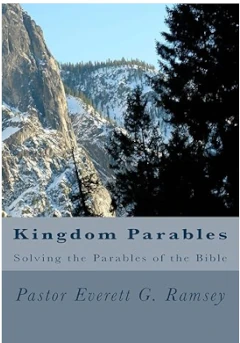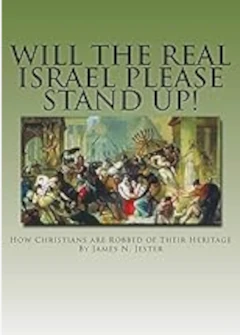Identifying Israel - Part 5
By Jim Jester
Complete series available in book format: Will the Real Israel Please Stand Up?
James 1:1, “James, a servant of God and of the Lord Jesus Christ, to the twelve tribes which are scattered abroad, greeting.”
From this opening statement of James we can see that he knew where the dispersed Israelites were. If the research is done we can learn much from history. The Bible is also a very reliable history book, but the establishment does not want us to be pointed anywhere near the Bible nor do they want anyone to take interest in it. Another thing; if the facts of history prove that the covenant people still exist in the world, then those claiming today to be the “chosen people” of God, would be proven wrong. This would be politically disastrous to their nation.
Parthia
At the time Rome ruled the Mediterranean area, Parthia ruled over much of Asia. The concept that the Roman Empire had a rival will come as a surprise to most readers. Parthia is almost totally omitted from history books; once again reminding us that we are taught history from a Greco-Roman perspective. Rome launched many wars against the Parthians but never conquered them. For nearly three centuries (64 B.C. – 225 A.D.) they acted as a balancing power equal to Rome. The Parthian Empire extended 1900 miles from east to west, the Indus and Euphrates Rivers, and 1000 miles from north to south, the Russian steppes to the Persian Gulf. They ruled far more benevolently than did Rome and offered “home rule” to many of its cities. Parthia’s provinces were basically self governing when it came to local matters. Even those nations or tribal groups who rebelled against Parthia and ended up under Roman dominance, later aided Parthia against Rome to once again come under Parthia’s benevolent rule! In our modern world, Rome’s totalitarianism was much like the former U.S.S.R, while Parthia was like the U.S., maintaining “federal” control over military and foreign matters; and giving freedom to its vassal kings locally. Yet most students today are taught that Rome was “civilized” and all others were “barbarians.”
The early historians maintain that the Parthians were a Scythic people. They also regarded them to be “exiles.” Their language was half Scythic, half Median. The Parthians originated in the area of Syria and Palestine where the Aramaic language (closely related to Hebrew) originated. The fact that the Parthians used a Semitic alphabet is evidence that their language and racial origin were Semitic (“White”). Their language, being related to the Hebrew, also indicates that they were among the descendants of Israel. (The Lost Ten Tribes of Israel Found, Stephen Collins, p. 208)
Also, there are many names that link them to the original kingdom of Israel. Their word for city was “Karta”, a shortened version of the Semitic, “kirjath”; from which Carthage (Kirjath Hadeschath – meaning “new city”) got its name. Its chief city was “Gaza”, named after the Gaza in Palestine (Rawlinson, Ancient History p. 474). Another prominent city was named “Asaak” where Arsaces, the Scythian founder, was crowned king. Notice how the name of “Isaac” is represented in these words; continuing God’s promise (Genesis 21:12) that “…through Isaac shall your descendants be named.”
Another interesting piece of history concerning Parthia is the “White Huns” (Encyclopedia Britannica, Vol. 8, p. 646); so called because of their light skin (evidence of Semitic origin). They were called the “Ephthalites” (also “Hephthalites” or “Nephthalites”). The encyclopedia adds that “the initial N… is believed to be a clerical error”, but gives no evidence as to why. Most students of the Bible can recognize with the letter “N” in front of “Ephthalites,” we have the tribe of Naphthali, one of the ten tribes of Israel. It is likely the Nephthalites kept their exact tribal name over the centuries because they were taken captive as a whole group rather than in pieces. The other Israelite tribes, who were taken in various groups at different times and in different directions, became known by their appropriate clan names. So, why is it “believed” that there is an “error” about this tribe when there is no evidence to support such a conclusion? It is because “establishment” histories do not want to find any of the “lost” tribes of Israel. To do so would mean that those (the Jews) who claim to be Israel today would be exposed. Also, they would not want any interest toward the Bible as a credible book. If establishment histories were to study Scythian or Parthian history to any depth at all, it would be impossible to miss an Israelite connection. Perhaps this is why their history is mostly ignored in the modern world.
The final piece of evidence linking the Israelite culture to the Parthian Empire is the name “Parthia” itself. The Hebrew consonants for “covenant” are B-R-T or B-R-TH, and were commonly used wherever the empire of Israel was dominant; such as seen in its colonies, Briton and Brittany, and in groups of Israelites, Brythonic Celts. In the ancient world the letters B and P were used interchangeably as they were very close phonetic sounds. Waddell notes that the Phoenicians interchanged the B’s and P’s in the Mediterranean world, and adds that the Phoenicians of Cilicia called the city of Tarsus “Parthenia.” The Greek explorer Pytheas referred to the British Isles by the term “Pretanic” (using the P) while Aristotle refers to them by the word “Britannic” (using the B). The Greeks could have easily written “Parthia” as “Barthia” or “Brithia.” In the Hebrew dictionary you will usually find the word “Briyth” (B-R-TH). Using the “P” as the consonant (P-R-TH) you have the identical sounds for “Parthia.” The identity of the Parthians is no longer a mystery! They were the covenant people of the ten tribes of Israel then living in Asia. An early king of their Scythian kinsmen named Partatua (circa 626 B.C.) included the P-R-T root word which foreshadowed the later name, “Parthia” (Rice, The Scythians, p. 45). Their very name declared to the world that they were the “covenant” people.
Political Struggles
Parthia, in its early years had little contact with Rome. It was a province of the Seleucid Greek Empire and declared its independence in 256-250 B.C., much like the Americans did from the British Empire. In their struggle they obtained help from their brethren, the Sacae Scythian tribes, just as Americans received assistance from the French. One result of their victory was that the Jewish (true descendants of Judah) Maccabees were able to assert their independence from the Seleucids. These Judahites even conquered the Idumeans (Edomites), who submitted to Jewish laws including circumcision. Josephus records that the Judahite Jews and Edomites became one people. This is an important note to remember for today’s Christian people who think that the “Jews” are God’s “Elect.” This is only true if “Jews” are descended from the tribe of Judah (remember in Part 2 of this series I gave various meanings for “Jew”) because Judah was an Israelite and in covenant with Yahweh. But if the “Jews” are a mixed race from Esau (Edomites) as Josephus noted, they became one people, then they cannot be among the Elect because God has said Israel is his Elect (See Isaiah 45:4).
Rome and Parthia did not come into contact with each other as enemies but rather as allies in a war with Armenia. The main reason there was an eventual rift between them was because Rome did not keep their word. There were many wars fought between them but I will not share all of them in this series of articles.
For the most part, I will let Collins give the account of the final war and demise of Parthia quoting from his book, The Lost Ten Tribes of Israel Found, pp. 253-256:
The final Roman-Parthian war began with immense treachery on the part of the Romans. In 215 A.D., the Emperor Caracullus, developed an elaborate “disinformation campaign” to dupe the Parthians into letting down their defenses. He proposed a peace settlement which would be cemented by a marriage between Caracullus and a daughter of the Parthian monarch. The Romans even proposed a political and economic union between Parthia and Rome. (Rawlinson, The Sixth Oriental Monarchy, p.352)
Even though Roman promises had never had any worth, the Parthians believed the deceitful Roman “peace initiative,” and allowed the Roman Emperor (escorted by a huge army) to proceed to the Parthian capital for the wedding. It is a testimony to the human capacity for self-delusion that the Parthians were so gullibly willing to believe the Romans in spite of every historical warning that such an offer could not be genuine. They continued in a state of denial even as Caracullus marched his army to Ctesiphon, Parthia’s western capital. Parthia so wanted to believe that Caracullus was a reformer, an enlightened man of peace, different from the warlike Romans of the past. The Parthians received the Romans with genuine hospitality, certain that a “New World Order” [to borrow a modern term] of peaceful harmony was beginning.
According to Herodian’s history, the Parthians “were transported with joy at the prospect of an eternal peace… and were keeping holiday” (Ibid, p. 354) as Caracullus and his army arrived. The Romans then dropped their pretense of peace and began slaughtering the gullible Parthians. The Parthian monarch barely escaped with his life. Not content with his already heinous betrayal of Parthian trust, the Romans then added massive insult to massive injury by desecrating the Parthian royal cemetery and scattering the remains of the deceased Parthian emperors. (Ibid p.356)
Outraged, the Parthians assembled a vast military force to take vengeance on the Romans. Based on subsequent events, it may have been the largest army Parthia ever assembled. Since Rome’s armies had never penetrated the huge interior of Parthia’s empire, most Parthian provinces had never experienced the treachery of Rome’s aggressions. However, all Parthians throughout the empire were outraged by the violations of the tombs and corpses of their dead emperors!
Indeed, Rome’s armies had never even come close to Parthia’s homeland, which was located southeast of the Caspian Sea. Ctesiphon, the “western capital” known to the Romans, was nowhere near the actual homeland of the Parthians. It is possible that Ctesiphon was an administrative center for governing their western provinces, but that other “capitals” existed eastward in their empire. …Given the historical relationship between Parthia and the Sacae tribes of Scythia, it is possible that Scythian tribes furnished troops for this battle as well.
The Roman headquarters in the areas was at Nisibis (near the modern border of Syria and Turkey). The enraged Parthian army headed for Nisibis to avenge themselves on the Romans. Caracullus had been assassinated prior to the arrival of the Parthians, and the new Roman emperor, Macrinus, tried to appease the Parthians by offering to return Parthian captives as part of a peace treaty. The Parthian emperor, Artabanus IV, spurned this offer as his army was there to exact vengeance and spill as much roman blood as possible.
The Parthian and Roman armies, both headed by their emperors, clashed in what must have been one of the fiercest (and bloodiest) battles ever fought in the ancient world. What occurred was not merely a battle, but the death struggle of two mighty empires. …It is recorded that the bodies of the dead were: “piled to such a height that the manoeuvres of the troops were impeded by them, and at last the two contending hosts could scarcely see one another!” (Ibid p. 360) At this point of mutual exhaustion, the battle ended [3 full days fighting] with a clear Parthian victory, Macrinus, the Roman emperor, fled the scene and afterward agreed to repatriate all Parthian captives and to pay a huge war indemnity to Parthia.
…The classical Greco-Roman historians wrote copiously about Scythian and Parthian history. As recent as 1888, a historian could still recognize the battle of Nisibis between Rome and Parthia as one of the greatest events of world history. Yet today, the important histories of Scythia and Parthia have been virtually erased from history texts. What caused this glaring omission?
During the nineteenth century, the famous historian George Rawlinson wrote books about the Parthian Empire in an attempt to counter what he called a “defective” and “false” view of history which omitted the major role of the Parthian Empire in world history. Is it only coincidental that modern history books deemphasize or omit the histories of empires founded by the ten tribes of Israel (Phoenicia, Carthage, Scythia and Parthia) while waxing eloquent about the histories of the non-Israelite empires? In the late nineteenth and twentieth centuries, the dogma of evolution became the new religion of a secularized world. It is now “politically incorrect” to have real faith in the Bible or the God of Israel. It hardly seems coincidental that the world’s awareness of the history of the ten tribes of Israel (an important biblical theme) declined even as evolution became the new “god” of modern, secularized culture.
The Parthian Empire had won a great victory over the Roman Empire. One would expect the Parthian Empire to be reinvigorated by its triumph, but, in fact, the end of its empire was at hand. It is recorded that, in this time of trial, Artabanus IV, Parthia’s emperor, sought to the occult for guidance and was told Parthia’s empire was about to end. (Ibid, p 173) This account echoes that of Saul, the first Israelite king, whose effort to seek occult guidance via an ancient “séance,” led to his defeat and death (I Samuel 28:7-25). Based on biblical precedent, it is a symptom of advanced moral decay in a society when its leaders seek to the occult (astrology, “channelers”, etc.) for guidance. Such actions not only forfeit God’s favor (via the sin of idolatry), but also invite his punishment. If God had divinely protected Parthia in earlier battles, this sin of Artabanus was especially grievous. …
In 220 A.D., the province of Persia revolted. A series of three battles was fought which resulted in a Persian victory in 227 A.D., costing Artabanus IV his life and effectively ending the Parthian Empire. The Sassanian Persian Empire replaced the Parthian Empire, and the Parthians were forced to migrate out of their old empire to flee the Persians. Some histories discuss Parthian history as part of “Persian” history, although this is misleading. Although the Parthians ruled the territory of the previous Persian Empire, the Parthians and Persians were two separate people in the same region of the world. The Parthians had been the subjects of the Persians before establishing their own empire, in which the Persians were a subject nation.
This was the end of Parthia. What became of the Parthians after they were forced out will be continued in Part 7 of this series.
This account of the final demise of Parthia should come as no surprise to Americans. Are the lies and corruption of the U.S. government today any different than that of Rome or Parthia? I think not. Many Americans cannot understand why their politicians do things, claimed by them to be in our best interest to help the country, which actually hurt the country. The same Americans usually think that the politicians are “stupid.” But are they really just “stupid” or is there a hidden motive behind their actions? There is no doubt in my mind that it is the latter. They are not stupid; most all of them are lawyers and highly educated. The motive of the U.S. government is to establish a world dictatorship sometimes known (in their words) as the “New World Order.” Most Americans have no concept of this idea since they are totally conditioned by the media to think that their government could never do such a traitorous thing. However, that number of Americans is shrinking. More of them are waking up, but if they do not hold themselves and their leaders accountable to God’s Law (not the Constitution) it will do no good, and the American empire will be lost. Americans must wake up to their heritage as descendants of Israel and their duty to obey the God of their fathers.












